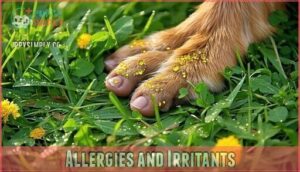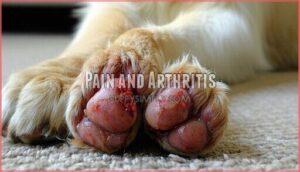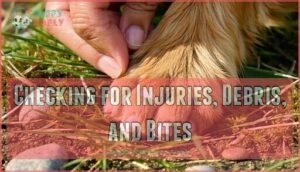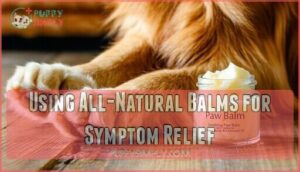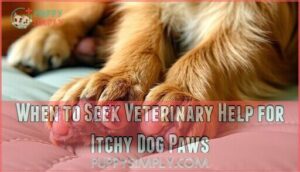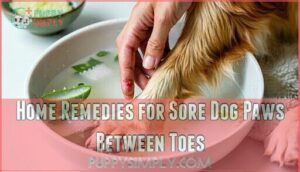This site is supported by our readers. We may earn a commission, at no cost to you, if you purchase through links.
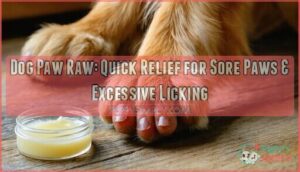 When your dog’s paw becomes raw from excessive licking, you’re dealing with a frustrating cycle that needs immediate attention.
When your dog’s paw becomes raw from excessive licking, you’re dealing with a frustrating cycle that needs immediate attention.
Raw paws typically result from allergies, yeast infections, injuries, or anxiety-driven behaviors.
Your pup’s constant licking creates moisture that allows bacteria to thrive, turning minor irritation into painful, inflamed skin.
Start by gently cleaning the affected area and checking for debris, cuts, or foreign objects between the toes.
Apply a protective balm to create a barrier against further irritation.
While minor cases respond well to home care, persistent licking or worsening symptoms require veterinary evaluation to identify underlying causes and prevent complications that could affect your dog’s mobility and comfort.
Table Of Contents
- Key Takeaways
- Understanding Excessive Paw Licking in Dogs
- Common Causes of Excessive Paw Licking
- Addressing and Managing Paw Licking
- When to Seek Veterinary Help for Itchy Dog Paws
- Home Remedies for Sore Dog Paws Between Toes
- Maintaining Healthy and Happy Dog Paws
- Frequently Asked Questions (FAQs)
- How do you treat raw paws on dogs?
- What can you put on your dog’s raw paws?
- How do you treat an irritated paw on a dog?
- Can raw paws heal without veterinary treatment?
- How long does paw healing typically take?
- Are certain dog breeds more susceptible to paw issues?
- What foods help prevent recurring paw problems?
- Should I bandage my dogs raw paws overnight?
- Conclusion
Key Takeaways
- Clean and inspect first – Check for cuts, debris, or foreign objects between toes before treating your dog’s raw paws, as hidden injuries need immediate attention to prevent infection.
- Break the licking cycle quickly – Apply protective balms and use booties or barriers to stop the moisture buildup that allows bacteria to thrive and worsens the raw condition.
- Don’t ignore underlying causes – Persistent licking often signals allergies, yeast infections, or anxiety that require targeted treatment beyond just treating the raw symptoms.
- Get professional help when needed – See your vet if there’s bleeding, pus, a foul odor, or if symptoms worsen after 3-5 days of home treatment to prevent serious complications.
Understanding Excessive Paw Licking in Dogs
Understanding your dog’s paw licking starts with recognizing normal grooming versus compulsive licking signs.
Behavioral paw licking often indicates underlying issues like allergies, infections, or anxiety. Some breeds show greater predispositions to dog paw problems, with English Bulldogs and Labradors being prime examples.
Watch for persistent licking that creates sore dog paw conditions or causes fur discoloration. This behavior’s health impact can worsen without proper intervention, leading to dog paw injury or infection.
Early prevention strategies include regular paw inspections and maintaining clean environments. Environmental allergens can also be a trigger, so inspect paws regularly for irritation.
Common Causes of Excessive Paw Licking
When your dog constantly licks their paws, it’s usually their way of telling you something’s wrong.
Understanding the root cause helps you provide the right treatment and get your furry friend back to comfortable walks.
Allergies and Irritants
Allergies and irritants rank among the top culprits behind your dog’s relentless paw licking.
Your dog’s paws are like canaries in a coal mine – they’re often the first to signal trouble brewing beneath the surface.
When your pup’s immune system overreacts to harmless substances, it triggers skin allergies like atopic dermatitis.
Pollen exposure during spring and fall seasons often sends dogs into licking frenzies, while dust mites lurking in your home can cause year-round discomfort.
Environmental allergens don’t stop there.
Chemical sensitivities from cleaning products, lawn treatments, or sidewalk salt can irritate sensitive paw pads.
Some dogs even develop food allergies that manifest as itchy paws – think of it as their body’s way of saying "something’s not right."
Breed predisposition plays a role too.
English Bulldogs and Labradors face higher risks due to their genetic makeup.
You’ll notice telltale signs: red, swollen skin between toes, brown saliva stains on fur, and that distinctive corn chip odor from moisture buildup.
The key is identifying your dog’s specific triggers through careful observation and veterinary testing.
Yeast Infections
Many dog paw infections stem from Malassezia dermatitis, where naturally occurring yeast overgrows between warm, moist toe pads.
You’ll notice telltale yeast symptoms like musty odors, brown discoloration, and persistent licking.
Infection prevention starts with proper paw hygiene—keeping those paws clean and dry works wonders.
For mild cases, topical treatments like antifungal creams provide relief.
However, severe paw inflammation often requires systemic antifungals prescribed by your vet to tackle stubborn infections effectively.
Allergies are often the underlying cause, leading to paw yeast infections that can cause persistent licking and require careful management to prevent further complications, including the use of systemic treatments.
Pain and Arthritis
Joint pain isn’t just an "old dog" problem—it affects pups of all ages.
Arthritis symptoms like stiffness and discomfort drive excessive paw licking as your dog seeks relief.
Breed predisposition matters too; larger breeds face higher risks.
Joint supplements and antiinflammatory treatments support dog paw health, while modified exercise routines prevent further paw inflammation and pain.
Anxiety
Sometimes stress and anxiety trigger compulsive licking behaviors in dogs, creating a frustrating cycle.
Your pup might develop separation anxiety or respond to environmental stressors by obsessively licking their paws.
Watch for behavioral signs like excessive grooming during stressful situations.
Stress reduction techniques, calming supplements, and consistent routines can help break this habit and provide effective paw licking remedies.
Addressing potential environmental allergens can also help reduce this behavior.
Addressing and Managing Paw Licking
When your dog’s paws are raw and irritated, the first step is checking for obvious problems like cuts, splinters, or insect bites that need immediate attention.
Once you’ve ruled out serious injuries, applying gentle, all-natural balms can provide quick relief while the healing process begins.
Checking for Injuries, Debris, and Bites
Start by looking over your dog’s paws like a detective searching for clues. Check each paw systematically for signs of injury, foreign objects, or bite marks that could be causing the excessive licking and creating a dog paw raw situation.
Paw Inspection Steps:
- Examine paw pads for cuts, cracks, or swelling
- Look between toes for embedded debris like thorns or stones
- Check for puncture wounds or bite marks from insects
- Assess nail condition and surrounding tissue for injury
Clean any wounds gently with warm water and monitor for signs of infection to prevent further complications.
Using All-Natural Balms for Symptom Relief
After checking for physical issues, all-natural dog paw balm offers targeted relief for raw paw treatment.
Balm ingredients like shea butter and coconut oil provide deep moisturization while creating protective barriers against irritants.
Application techniques are straightforward—gently massage balm into pads and between toes for complete coverage.
Balm benefits include reduced inflammation, accelerated healing, and long-lasting protection.
Balm safety is paramount; choose products with food-grade ingredients since dogs often lick their paws.
While DIY balms using coconut oil and beeswax work well, commercial dog paw remedies offer consistent formulations.
These home remedies provide convenient, effective relief for ongoing paw issues.
Many balms utilize natural oils and butters to provide essential moisture.
When to Seek Veterinary Help for Itchy Dog Paws
While watching your dog obsessively lick their paws might seem like harmless grooming, recognizing when professional veterinary attention becomes necessary can save your pet from prolonged discomfort and serious complications.
Severe Symptoms requiring immediate veterinary care include:
- Infection Signs – bleeding, pus, foul odor, or open wounds between toes
- Sudden Changes – persistent limping, swelling, or reluctance to walk
- Unresponsive Treatment – symptoms worsening despite home remedies after 3-5 days
Your dog paw vet will examine for Underlying Conditions like bacterial infections, yeast overgrowth, or systemic allergies.
Don’t wait if you notice aggressive scratching causing raw skin, continuous licking creating sores, or behavioral changes like increased irritability. Environmental allergens can also trigger these symptoms, necessitating a vet visit.
Dog paw allergies treatment often requires prescription medications that home remedies can’t provide.
Early veterinary advice prevents minor issues from becoming major problems, and professional veterinary care guarantees proper diagnosis through cytology or cultures when needed.
Home Remedies for Sore Dog Paws Between Toes
When dealing with a sore dog paw, natural remedies offer gentle relief right from your kitchen. These time-tested solutions can soothe irritated paw pads and reduce excessive dog paw licking without harsh chemicals.
Chamomile Soak provides excellent anti-inflammatory benefits. Steep 3-4 tea bags in warm water, let cool, then soak your dog’s paws for 5-10 minutes twice daily. The natural compounds calm irritated skin between toes.
Salt Benefits include natural antibacterial properties. Mix one cup of high-quality sea salt with 3-4 cups of warm water for an effective cleansing solution that promotes healing.
Aloe Application works wonders for raw areas. Apply pure aloe vera gel after soaking to lock in moisture and accelerate healing.
| Remedy | Application | Benefits |
|---|---|---|
| Chamomile Soak | 5-10 minutes, twice daily | Reduces inflammation, soothes irritation |
| Salt Solution | Soak and lift method | Antibacterial, promotes healing |
| Aloe Vera | Thin layer after soaking | Moisturizes, speeds recovery |
Paw Balms with natural ingredients provide ongoing protection. To further protect your dog’s paws, consider using specialized paw protection.
Diet Improvement with omega-3 fatty acids supports healing from within. Always clean with antiseptic wipes before applying home remedies.
Maintaining Healthy and Happy Dog Paws
Prevention beats treatment in dog paw care. Regular nail trims prevent ingrown toes and painful snags that damage paw pads. Check between pads frequently for debris or injury signs.
Use booties and protection during extreme weather conditions like snow, hot pavement, or salt exposure. Paw pad hydration through moisturizing balms prevents cracking and maintains healthy paws. Consider using a quality paw protector for added defense.
Essential Paw Care Steps:
- Weekly paw cleaning with lukewarm water removes allergens and irritants
- Monthly nail maintenance prevents abnormal gait and excessive pad wear
- Daily visual inspections catch problems before they worsen, especially for breeds with predispositions
- Protective barriers like waxes shield against environmental hazards
- Quality diet and paws connection – omega-3 supplements support skin health
Regular vet checkups guarantee minor issues don’t become major problems.
Frequently Asked Questions (FAQs)
How do you treat raw paws on dogs?
Over 80% of dogs with raw paws show redness and swelling.
Clean affected areas with antiseptic wipes, apply soothing paw balms, and limit activity on hard surfaces.
Consult your vet for proper diagnosis and treatment.
What can you put on your dog’s raw paws?
You can apply antiseptic wipes, soothing paw balms, or protective booties to your dog’s raw paws.
Always clean the area first and consult your vet before trying home remedies like coconut oil or aloe gel.
How do you treat an irritated paw on a dog?
Over 80% of dogs with raw paws show redness and swelling. Clean the irritated area with antiseptic wipes, apply soothing paw balm, and limit activity on rough surfaces until healed.
Can raw paws heal without veterinary treatment?
While mild raw paws might heal on their own, you’ll risk serious infections and complications.
Professional treatment guarantees proper diagnosis and prevents underlying issues from worsening, making recovery faster and safer.
How long does paw healing typically take?
Time heals all wounds, but patience isn’t your strongest suit! Mild paw injuries typically heal within 5-7 days, while deeper wounds need 2-3 weeks with proper care and rest.
Are certain dog breeds more susceptible to paw issues?
Yes, certain breeds face higher paw problem risks.
English Bulldogs and Labradors are particularly susceptible due to their anatomy and activity levels.
Breeds with flat faces, heavy builds, or excessive skin folds between toes create perfect conditions for moisture retention and bacterial growth, which can be exacerbated by moisture retention.
What foods help prevent recurring paw problems?
Premium dog food with omega-3 fatty acids reduces inflammation.
Fresh vegetables, fruits, and fish oil supplements support immune function.
Probiotics improve gut health, while avoiding allergens like certain grains helps prevent recurring paw issues with probiotics.
Should I bandage my dogs raw paws overnight?
Like wrapping a scraped knee, you’ll want to bandage your dog’s raw paws overnight to prevent further damage.
Use breathable, loose bandages that won’t restrict circulation—think snug sock, not tourniquet.
Conclusion
Nearly 60% of dogs who develop chronic paw licking continue the behavior even after the original irritation heals, creating a stubborn cycle.
Managing your dog paw raw requires patience and consistency. You’ve learned to identify causes, provide immediate relief, and recognize when professional help‘s needed.
Remember that most paw problems resolve with proper care, but don’t hesitate to contact your vet if symptoms persist or worsen.
- https://www.thekennelclub.org.uk/health-and-dog-care/health/health-and-care/a-z-of-health-and-care-issues/hot-pavements/
- https://onlinelibrary.wiley.com/doi/abs/10.1046/j.1365-3164.2000.00193.x
- https://www.deepdyve.com/lp/wiley/treatment-of-canine-atopic-dermatitis-2010-clinical-practice-ztRM4nDpxm
- https://miamivetderm.com/
- https://nam04.safelinks.protection.outlook.com/?url=https%3A%2F%2Fwww.akc.org%2Fexpert-advice%2Fhealth%2Fdog-allergies-symptoms-treatment%2F&data=05%7C02%7CMelanie.Haid%40akc.org%7Ce59110209c794e955d8b08dc2c07ffff%7Cdebe5afe05c34246a4c038ab75946c0f%7C0%7C0%7C638433660073077200%7CUnknown%7CTWFpbGZsb3d8eyJWIjoiMC4wLjAwMDAiLCJQIjoiV2luMzIiLCJBTiI6Ik1haWwiLCJXVCI6Mn0%3D%7C0%7C%7C%7C&sdata=%2Flr6lEe%2F1%2B4%2Bk5bc%2B0dRELZaDIz3f1dQeJz4T8t%2FU18%3D&reserved=0

